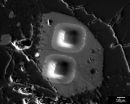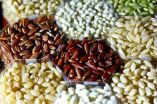(Press-News.org) A recent review of hundreds of chemical analyses of Moon rocks indicates that the amount of water in the Moon's interior varies regionally – revealing clues about how water originated and was redistributed in the Moon. These discoveries provide a new tool to unravel the processes involved in the formation of the Moon, how the lunar crust cooled, and its impact history.
This is not liquid water, but water trapped in volcanic glasses or chemically bound in mineral grains inside lunar rocks. Rocks originating from some areas in the lunar interior contain much more water than rocks from other places. The hydrogen isotopic composition of lunar water also varies from region to region, much more dramatically than in Earth.
The present consensus is that the Moon formed as the result of a giant impact of an approximately Mars-sized planetesimal with the proto-Earth. The water in the Moon is a tracer of the processes that operated in the hot, partly silicate gas, partly magma disk surrounding Earth after that impact.
The source of the Moon's water has important implications for determining the source of Earth's water, which is vital to life. There are two options: either, water was inherited by the Moon from the Earth during the Moon-forming impact, or it was added to the Moon later by comets or asteroids. It might also be a combination of these two processes.
"Basically, whatever happened to the Moon also happened to the Earth," said Katharine Robinson, lead author of the study and Graduate Assistant at the University of Hawai'i – Mānoa (UHM) School of Ocean and Earth Science and Technology.
Robinson and Researcher G. Jeffrey Taylor, both at the UHM Hawai'i Institute of Geophysics and Planetology, compiled water measurements from lunar samples performed by colleagues from around the world, as well as their own. Specifically, they measured hydrogen and its isotope, deuterium (hydrogen with an extra neutron in its nucleus) with ion microprobes, which use a focused beam of ions to sputter ions from a small rock sample into a mass spectrometer. The ratio of hydrogen to deuterium can indicate the source of the water or trace magmatic processes in the lunar interior.
When water was first discovered in lunar samples in 2008, it was very surprising because from the time Apollo astronauts brought lunar samples, scientists thought that the Moon contained virtually no water.
"This was consistent with the idea that blossomed during the Origin of the Moon conference in Kona in 1984 -- that the Moon formed by a giant impact with the still-growing Earth, leading to extensive loss of volatile chemicals. Our work is surprising because it shows that lunar formation and accretion were more complex than previously thought," said Robinson.
The study of water in the Moon is still quite new, and many rocks have not yet been studied for water. The HIGP researchers have a new set of Apollo samples from NASA that they will be studying in the next few months, looking for additional clues about the early life of Earth and the Moon.
INFORMATION: END
Water in moon rocks provides clues and questions about lunar history
2014-05-28
ELSE PRESS RELEASES FROM THIS DATE:
Ultraviolet cleaning reduces hospital superbugs by 20 percent: Study
2014-05-28
Washington, DC, May 27, 2014 – Healthcare-associated vancomycin-resistant enterococcus (VRE), methicillin-resistant Staphylococcus aureus (MRSA), Clostridium difficile (CD), and other multidrug-resistant organisms (MDRO) were decreased among patients after adding ultraviolet environmental disinfection (UVD) to the cleaning regimen, according to a study published in the June issue of the American Journal of Infection Control, the official publication of the Association for Professionals in Infection Control and Epidemiology (APIC).
In this retrospective study led by the ...
What can plants reveal about gene flow? That it's an important evolutionary force
2014-05-28
A plant breeder discovers his experimental crops have been "contaminated" with genes from a neighboring field. New nasty weeds sometimes evolve directly from natural crosses between domesticated species and their wild relatives. A rare plant is threatened due to its small population size and restricted range. What do all these situations have in common? They illustrate the important role of gene flow among populations and its potential consequences. Although gene flow was recognized by a few scientists as a significant evolutionary force as early as the 1940s, its relative ...
In Africa, STI testing could boost HIV prevention
2014-05-28
PROVIDENCE, R.I. [Brown University] — To maximize HIV prevention efforts in South Africa and perhaps the broader region, public health officials should consider testing for other sexually transmitted infections when they test for HIV, according to a new paper in the journal Sexually Transmitted Infections.
STIs can make HIV easier to transmit even after antiretroviral therapy has begun, so rooting out STI co-infections in patients should improve HIV prevention. The new study led by Brown University public health researchers emphasizes that sooner is indeed better than ...
Variety in diet can hamper microbial diversity in the gut
2014-05-28
AUSTIN, Texas — Scientists from The University of Texas at Austin and five other institutions have discovered that the more diverse the diet of a fish, the less diverse are the microbes living in its gut. If the effect is confirmed in humans, it could mean that the combinations of foods people eat can influence the diversity of their gut microbes.
The research could have implications for how probiotics and diet are used to treat diseases associated with the bacteria in human digestive systems.
A large body of research has shown that the human microbiome, the collection ...
Melting Arctic opens new passages for invasive species
2014-05-28
For the first time in roughly 2 million years, melting Arctic sea ice is connecting the north Pacific and north Atlantic oceans. The newly opened passages leave both coasts and Arctic waters vulnerable to a large wave of invasive species, biologists from the Smithsonian Environmental Research Center assert in a commentary published May 28 in Nature Climate Change.
Two new shipping routes have opened in the Arctic: the Northwest Passage through Canada, and the Northern Sea Route, a 3000-mile stretch along the coasts of Russia and Norway connecting the Barents and Bering ...
3,000 rice genome sequences made publicly available on World Hunger Day
2014-05-28
The open-access, open-data journal GigaScience (published by BGI and Biomed Central), announces today the publication of an article on the genome sequencing of 3000 rice strains along with the release of this entire dataset in a citable format in journal's affiliated open-access database, GigaDB. The publication and release of this enormous data set (which quadruples the current amount of publicly available rice sequence data) coincides with World Hunger Day to highlight one of the primary goals of this project— to develop resources that will aid in improving global food ...
High-status co-eds use 'slut discourse' to assert class advantage
2014-05-28
WASHINGTON, DC, May 27, 2014 — A new study suggests that high-status female college students employ "slut discourse" — defining their styles of femininity and approaches to sexuality as classy rather than trashy or slutty — to assert class advantage and put themselves in a position where they can enjoy sexual exploration with few social consequences.
"Viewing women only as victims of men's sexual dominance fails to hold women accountable for the roles they play in reproducing social inequalities," said lead author Elizabeth A. Armstrong, an associate professor of sociology ...
Prehistoric birds lacked in diversity
2014-05-28
Birds come in astounding variety—from hummingbirds to emus—and behave in myriad ways: they soar the skies, swim the waters, and forage the forests. But this wasn't always the case, according to research by scientists at the University of Chicago and the Field Museum.
The researchers found a striking lack of diversity in the earliest known fossil bird fauna (a set of species that lived at about the same time and in the same habitat). "There were no swans, no swallows, no herons, nothing like that. They were pretty much all between a sparrow and a crow," said Jonathan ...
Cod bones reveal 13th century origin of global fish trade
2014-05-28
London's international fish trade can be traced back 800 years to the medieval period, according to new research published today in the journal Antiquity.
The research, led by archaeologists from UCL, Cambridge and UCLan, provides new insight into the medieval fish trade and the globalisation of London's food supply.
Archaeologists analysed data from nearly 3,000 cod bones found in 95 different excavations in and around London. They identified a sudden change in the origin of the fish during the early 13th century, indicating the onset of a large-scale import trade.
Lead ...
Butterfly 'eyespots' add detail to the story of evolution
2014-05-28
CORVALLIS, Ore. – A new study of the colorful "eyespots" on the wings of some butterfly species is helping to address fundamental questions about evolution that are conceptually similar to the quandary Aristotle wrestled with about 330 B.C. – "which came first, the chicken or the egg?"
After consideration, Aristotle decided that both the egg and the chicken had always existed. That was not the right answer. The new Oregon State University research is providing a little more detail.
The study, published today in Proceedings of the Royal Society B, actually attempts to ...





